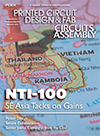YAVNE, ISRAEL – Valor Computerized Systems announced full support and integration of its Trilogy 5000 assembly line automation software with the SIPlace Pro interface used in Siemens' placement systems.
The integration is important because Siemens has close to a 30% market share worldwide in the component placement market.
The integration enables users to optimize their assembly lines, Valor said.
In a statement, Valor executive vice president for marketing and product management Julian Coates said, “The seamless integration between Valor’s Trilogy 5000 advanced assembly line engineering solution and the powerful SIPlace Pro open interface delivers tremendous cost savings to Siemens customers by generating the fastest route from data load to optimized machine program generation. Siemens customers will enjoy reduced NPI cycle time, increased shop floor productivity, and quicker machine programming and set-up times.”
The Valor tool improves CAD/BoM loading, stencil optimization, rotation neutralization, first-rate machine/line optimization and balancing and NPI debug time, among other features, Valor said.
The integration is important because Siemens has close to a 30% market share worldwide in the component placement market.
The integration enables users to optimize their assembly lines, Valor said.
In a statement, Valor executive vice president for marketing and product management Julian Coates said, “The seamless integration between Valor’s Trilogy 5000 advanced assembly line engineering solution and the powerful SIPlace Pro open interface delivers tremendous cost savings to Siemens customers by generating the fastest route from data load to optimized machine program generation. Siemens customers will enjoy reduced NPI cycle time, increased shop floor productivity, and quicker machine programming and set-up times.”
The Valor tool improves CAD/BoM loading, stencil optimization, rotation neutralization, first-rate machine/line optimization and balancing and NPI debug time, among other features, Valor said.
BEIJING -- China has issued its version of the Restriction of Hazardous Substances directive; the Chinese version was promulgated on Feb. 28 and takes effect March 1, 2007.
An copy of the law in English is available here.
An copy of the law in English is available here.
LONDON -- A survey conducted by the SMART Group during its annual Lead-Free Seminar in February found the
majority of respondents will either not be ready or are uncertain about
meeting requirements by the compliance date. Also, a large number of
companies believe they are exempt from the RoHS Directive.
The top challenges to being noncompliant by July 1 were noted as:
lack of availability of Pb-free components, compliance issues, cost of
stock to support spares, reliability, moisture sensitive devices,
rework and repair.
KEY LARGO, FL – William (Bill) Scheu, president of Automated Production Equipment (A.P.E.), died March 1 of a heart attack.
Scheu is survived by his wife, Barbara, sons Casey and Ian, and four grandchildren.
A memorial was held today in Key Largo.
Visitation will be held at Grubbs Funeral Home in Wytheville, VA, on March 9. Scheu will be buried March 10 at the Family Cemetery in Wytheville. Services will begin at 11 a.m. at the Galilee Christian Church.
In a statement Scheu’s colleague David Horvath said, “Bill meant much to many people, from the response we have seen only after a few hours … and to us he was a friend, leader, father, mentor all at the same time.
“Bill encouraged many friends throughout the world and was a support to many with sage advice and a helping hand. His askance humor, sharp intellect and piercing observation will be sadly missed.”
Scheu is survived by his wife, Barbara, sons Casey and Ian, and four grandchildren.
A memorial was held today in Key Largo.
Visitation will be held at Grubbs Funeral Home in Wytheville, VA, on March 9. Scheu will be buried March 10 at the Family Cemetery in Wytheville. Services will begin at 11 a.m. at the Galilee Christian Church.
In a statement Scheu’s colleague David Horvath said, “Bill meant much to many people, from the response we have seen only after a few hours … and to us he was a friend, leader, father, mentor all at the same time.
“Bill encouraged many friends throughout the world and was a support to many with sage advice and a helping hand. His askance humor, sharp intellect and piercing observation will be sadly missed.”
ATLANTA -- In his Web log today, Circuits Assembly editor Mike Buetow discusses "greenwashing" -- the practice of mischaracterizing something as environmentally friendly despite scientific evidence to the contrary -- and Wikipedia.
SALT LAKE CITY -- CirTran Corp., a small contract manufacturer, projected its first-ever annual profit for fiscal 2005 on revenues of about $13 million, a jump of 45%.
Press Releases
- Innominds and SIIX launch SIIX-Innominds JV to offer full-stack ODM services in India
- Syrma SGS Technology, Ltd to Accelerate AI-Driven Manufacturing with implementation of analytics and AI solution from Arch Systems in partnership with NMTronics India
- TTCI and The Training Connection Strengthen Electronics Manufacturing with Test Services and Training at PCB West 2025
- SMTA “Members of Distinction” Awards Announced


